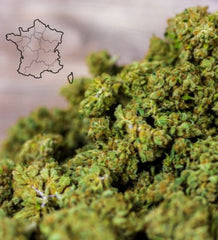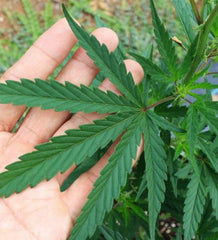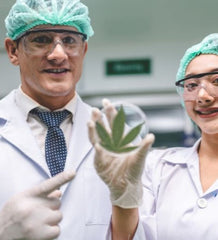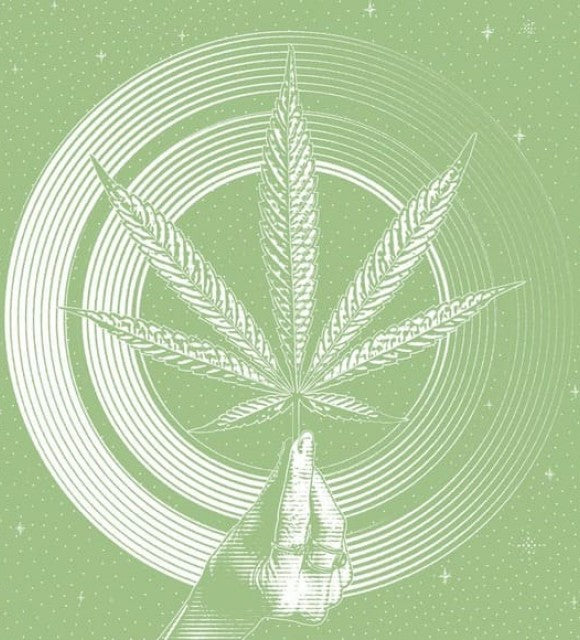
Why consume cannabis without THC?
What is THC-free cannabis?
Of the more than 100 different chemical compounds found in the plant, CBD (cannabidiol) and THC (tetrahydrocannabinol) are the most well-known. But what does "THC-free" really mean?
When we talk about "THC-free" CBD, it technically means that there is no "quantifiable" or "detectable" THC in the product. However, this does not mean that the THC level is 0%.
The reason why it's impossible to have 0% THC is simple: Even with a CBD:THC ratio of 20:1, that is, containing 20 times more CBD than THC, there is still a trace of THC. As the CBD level increases, so does the THC level, even on a small scale. This is why it's difficult to find flowers that contain more than 30% CBD, because that would mean they contain a THC level higher than 0.3%.
All broad-spectrum CBD products on the market contain a tiny amount of THC, since CBD is derived from plants along with many other plant constituents, including other cannabinoids like THC.
Chemistry and the quality of lab equipment can help give a more precise meaning to the term "THC-free" while also justifying why it is a fair term to use for certain products.
When looking at other CBD products that advertise "THC-free," it's very important to dig into the Certificate of Analysis and make sure it defines the actual limit for THC.
If a Certificate of Analysis states "N/A," meaning "not detected," instead of an actual number (e.g., 0.02%), it must state the actual minimum threshold it considers non-detectable.
If the limit of quantification is not disclosed, you don't actually know what level of THC is being tested at.
Cannabis with THC vs. without THC
There are some differences between THC-free and THC-containing cannabis products. CBD is a molecule with calming properties . It is the second most common active ingredient after THC.
However, unlike THC, CBD does not produce psychoactive effects . It does not alter the user's mind, emotions, or behavior. This means you won't get "stoned" on CBD like you would on THC.
Both CBD and THC affect the human brain, but in different ways. When you take CBD, it acts on cannabinoid receptors (CB2).
The CBD will then bind to the CB2. However, the action does not release dopamine as would normally happen with THC. This is why taking CBD does not trigger a feeling of "high" or euphoria in users .
CBD can also bind to cannabinoid receptor 1 (CB1), but it won't be as potent as THC and CB1. This requires combining CBD with THC so it can properly bind to CB1 receptors. This can help minimize the psychoactive effects of THC, such as sedation or euphoria.
CBD is known to promote well-being and relaxation . People suffering from conditions such as stress, anxiety , chronic pain, sleep disorders , mood disorders, appetite disorders, and nausea can greatly benefit from it.
CBD (cannabis without THC) is particularly known for its effects:
- antiepileptics;
- anxiolytics;
- anti-inflammatories;
- painkillers;
- immunomodulators;
- antipsychotics;
- neuroprotectors.
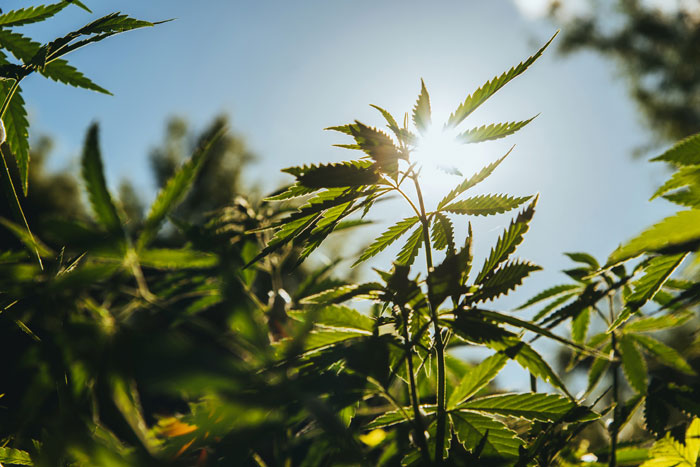
Why consume hemp without THC?
Scientists have been exploring the possibility of using THC-free hemp for years in medical settings.
THC-free cannabis to slow Alzheimer's disease
Research has found memory improvements with THC-free cannabis, which helps slow the production of amyloid plaques in patients with Alzheimer's disease.
THC-free cannabis for inflammatory diseases
Another study showed that CBD can also help manage pain and inflammation. Researchers applied the cannabinoid to the skin of animals. This reduced pain and inflammation due to arthritis.
Another study also examined CBD's potential to inhibit inflammatory and neuropathic pain, two of the most difficult types of chronic pain to treat in patients.
While these initial results are promising, further studies are needed to prove the link between CBD and pain control.
THC-Free Cannabis for Sleep Disorders
THC-free weed has become an increasingly popular solution for sleep disorders, hailed by users as helping them get a restful night's sleep without the drowsiness and other side effects that accompany traditional sleeping pills.
THC-free cannabis for childhood epilepsy
CBD could also hold the key to treating people with epilepsy. Research is underway to determine the extent to which the cannabinoid can help reduce the number of seizures in epilepsy patients. Research is also underway to determine how safe its use is.
In a 2016 study, researchers administered oral doses of 2 to 5 mg of cannabidiol daily to 214 people with epilepsy. They added the cannabinoid to the patients' existing antiepileptic medications.
The researchers then followed the participants for 12 weeks, noting any negative side effects from the cannabidiol doses. They also noted the participants' seizure frequency.
By the end of the program, participants had experienced 36.5% fewer seizures per month.
Note that Epidiolex is the first CBD medication approved by the FDA (Food and Drug Administration) since 2018. This prescription-only medication is used for its anticonvulsant properties in Lennox-Gastaut syndrome and Dravet syndrome.
THC-Free Cannabis for Stress and Anxiety
Most common mental health disorders such as anxiety and depression are usually treated with medications that cause side effects such as drowsiness, agitation, nervousness, nausea, and headaches. Some medications, such as benzodiazepines, can even be highly addictive. This is why many people are turning to natural alternatives like CBD to regain their joy and good mood.
Thanks to its regulatory action on brain receptors for serotonin , the neurotransmitter that affects mood and social behavior, CBD naturally reduces stress and anxiety disorders.
Please note: CBD should not be considered a treatment for severe anxiety disorders or depression. If in doubt, seek professional advice.
THC-free cannabis for skin
Finally, CBD can be used in the form of cream, gel, balm or even oil to be applied directly to the skin.
The advantage of CBD is that it adapts to all skin types. It is even recommended for the most sensitive skin.
Some dermatologists recommend using CBD for eczema , psoriasis , itching, redness, and other skin conditions.

What effect does cannabis without THC have?
THC-free cannabis (cannabidiol) has anti-inflammatory and antioxidant action , which may be effective against types of pain associated with oxidative stress and greater inflammation.
CBD is generally used for:
- promote relaxation and well-being on a physical and mental level;
- combat sleep disorders such as insomnia;
- relieve chronic or temporary pain;
- reduce stress and anxiety;
- regulate appetite and mood.
Although CBD is non-psychotropic, it can still cause some notable side effects in users. However, the compound is considered more tolerable by the body than THC, even when taken in high doses. Mild side effects include fatigue, nausea, and loss of appetite.
Is THC legal in France?
Cannabis containing THC is illegal in France and is classified as a narcotic . However, CBD products (oils, resins, herbal teas, etc.) are not considered narcotics and can be used 100% legally, provided that certain restrictions have been followed in their production.
Interestingly, France is the only Western country that has not banned the cultivation of hemp seeds. Growers are therefore free to experiment with their own production of cannabidiol oils.
Indeed, the popularity of cannabidiol has exploded in France and around the world, as has the number of people using hemp seeds to produce their own CBD oils. However, as you might expect, there are some restrictions on the production of CBD oils in France:
- The hemp used must come from one of a few government-approved seeds or varieties;
- The use, possession, and sale of cannabidiol are only legal if the product contains less than 0.3% THC. If the product contains more than 0.3% THC, it is considered a narcotic;
- Cannabidiol consumers in France should choose products made from cannabidiol isolates to avoid falling foul of the 0.3% THC limit.
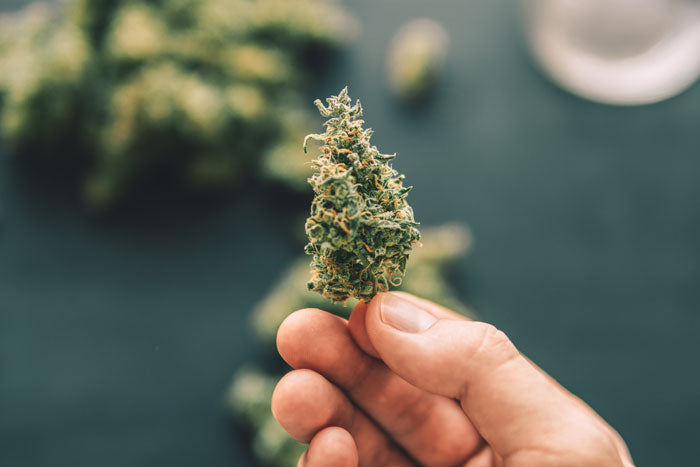
What are the best THC-free cannabis flowers on Famous CBD?
We have selected for you 3 quality THC-free cannabidiol flowers in our flower category:
This is a perfectly balanced hybrid strain. Its unique resinous consistency makes it very pleasant to consume. Its large flowers have a beautiful color, like light green with beautiful orange hues. With its indoor cultivation, its unique terpene richness, and its sweet citrus aroma, this CBD flower will delight the taste buds of hemp lovers. With a CBD content of 23%, you can get it for €4.27/g.
This is a flowering CBD plant with sweet, coffee-like notes that inspires royalty. Famous CBD strains are grown indoors and are rich in CBD. They exhibit very interesting physical properties and traits. Gorilla Queen is prized for its rich trichomes and fresh pine aroma, which makes it unique. Have this flower, containing 21.7% CBD, delivered to you from €4.27/g.
This flower can be used not only as an infusion but also as a vaporizer. It's one of the highest-quality and most popular indoor hemp varieties on the market. It has a CBD content of 24.4%, providing powerful relaxing effects.
Several delivery options are available, including one that's free with no minimum purchase. Delivery is made from France to ensure fast and discreet packaging, starting from €5.56/g.
In conclusion: what is the point of consuming cannabis without THC?
In conclusion, we can say that cannabis without THC, or simply CBD, is a healthy and legal way to consume hemp .
If you want to discover the multiple therapeutic virtues of hemp without the harmful and psychoactive effects of THC , you must opt for CBD.
Furthermore, it seems important to remember that cannabis with THC is illegal, in addition to being bad for your health.
Then choose CBD without THC to benefit from relaxing and soothing effects every day!




